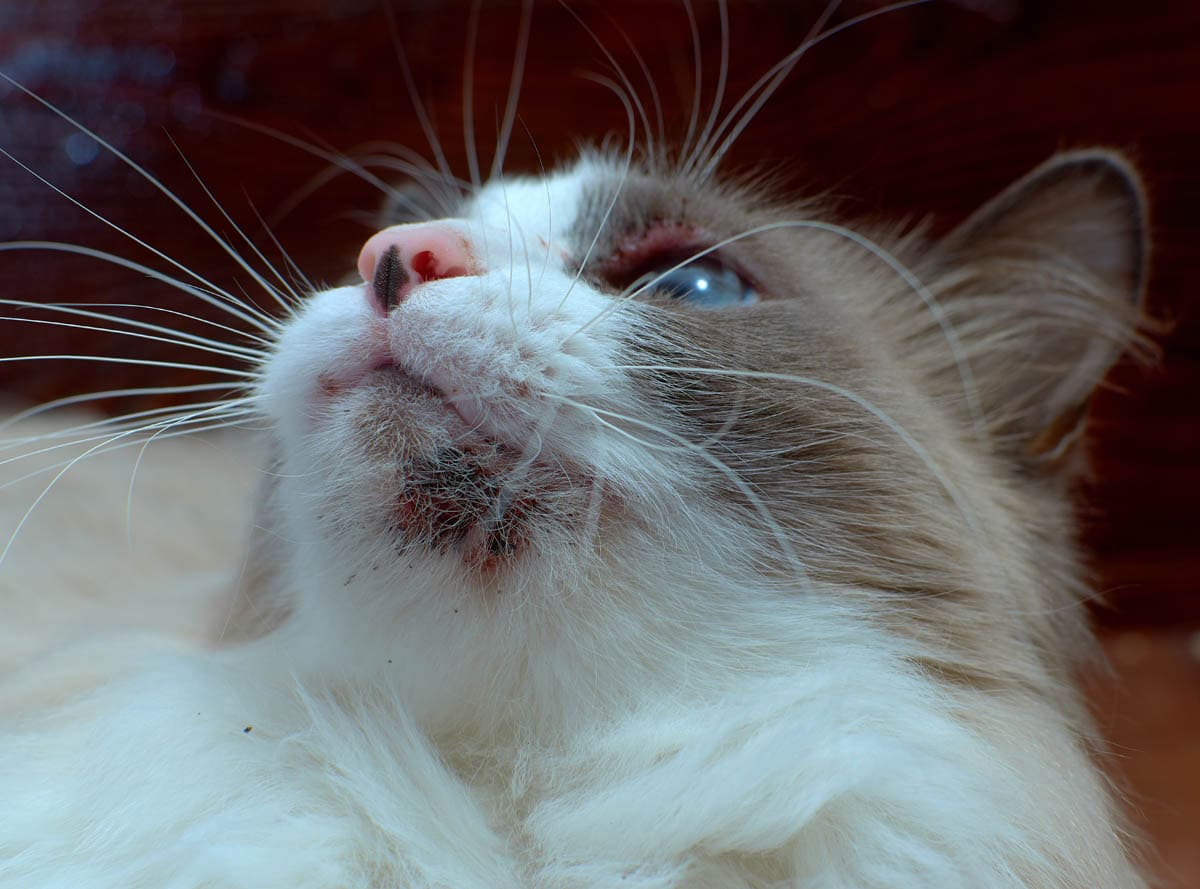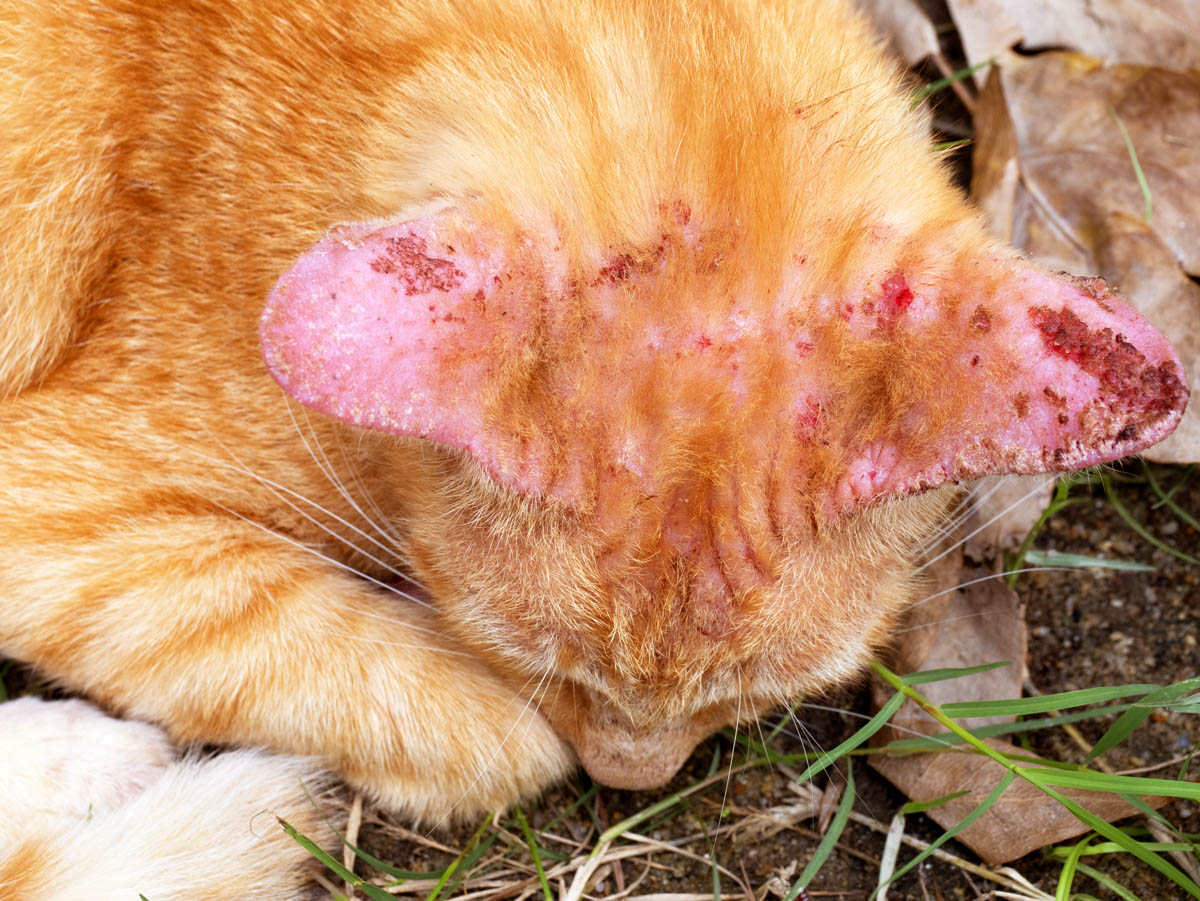Contact dermatitis
The least common of the four types of allergy in cats. Contact dermatitis is a result of the cat coming into contact with a substance. The cat’s fur acts as a barrier, protecting it from allergy-producing compounds. There are two causes of contact dermatitis which are allergic and irritant.
Symptoms:
- Non-seasonal itching, especially in areas where there isn’t much fur. Typical areas include the chin, ears, toes, underbelly, and anus.
- Lesions of any type: redness, rash, papules (pimple-like), vesicles, and blisters
- Skin redness or inflammation
- Thickening of the skin
Treatment:
- Identification and elimination of the substance causing contact dermatitis is the best solution.
- Corticosteroids to reduce inflammation and itchiness.
- Antibiotics may be necessary to treat secondary bacterial infections.
Feline acne

Feline acne is a common problem that affects the cat’s chin and lips. Often symptoms are so mild that they go unnoticed. Acne can affect cats of any age, sex or breed. Sebaceous glands secrete oils (known as sebum) that lubricate the skin, preventing dryness and irritation.
Symptoms:
- Chin swelling
- Blackheads
- Redness
- Inflammation
- Severely affected cats may develop open sores which become infected
Treatment:
Topical antiseborrheic medications such as OxyDex, topical antibiotics, topical glucocorticoids to reduce inflammation and omega fatty acids. Switching from plastic to ceramic or metal food and water dishes, which should be thoroughly cleaned at least once a day.
Flea allergy dermatitis
Flea allergy dermatitis (flea bite hypersensitivity) is the most common skin allergy in cats. As the name suggests, it is caused by an allergic reaction to a flea bite.
Symptoms:
Frequent scratching and biting of the fur, especially on the back and the base of the tail, raised bumps (papules) or scabs on the skin, thinning fur in the affected area.
Treatment:
- Eliminating fleas from your cat and environment, and preventing re-infestation.
- Treating secondary skin infections caused by excessive biting and scratching of the skin. This may involve a course of antibiotics, medicated shampoo and or topical medication.
- Antihistamines or steroids may be prescribed by your veterinarian to control inflammation and reduce itching.
- Hyposensitization (desensitization). This involves injecting minute amounts of flea antigen into the cat in the hope that it will re-programme the immune system so it’s not hypersensitive to flea antigen.
Food allergy
This is caused by an allergic reaction to one or more ingredients in the cat’s food. The most common causes of food allergies are fish, beef, eggs, wheat, and milk. Cats can become allergic to foods they have eaten for a long period of time.
Symptoms:
Nonseasonal itching, especially on the front half of the body and head, hair loss (due to excessive scratching), vomiting and or diarrhea, the ears may be swollen and or infected.
Treatment:
Avoiding the food which caused the allergies is the best method of treatment, this may either be a homemade diet or a hypoallergenic diet.
Miliary dermatitis

Also known as miliary eczema, papula crusting dermatitis or scabby cat disease, miliary dermatitis is a disease complex characterised by a red and crusty rash around the head, neck, and back, often with intense itching. There are several causes which include flea allergy dermatitis, drug hypersensitivity, allergies, bacterial infections, mites, ringworm, immune-mediated disease, poor diet, and hormonal disorders.
Symptoms:
- Red, crusty bumps, especially around the head, neck, and back
- Itching
- Scratching
- Hair loss
Treatment:
- Removal of the fleas from the cat and environment with a veterinary prescribed flea treatment as well as a pet-approved insecticide in the home and garden. Routine flea control to ensure miliary dermatitis doesn’t recur.
- The same goes for mites, mange or fungal or yeast infections. Treat the cause and miliary dermatitis should go away.
- If intestinal parasites are found to be the cause, treatment with the appropriate medication to eliminate them.
- A hypoallergenic diet may be tried if parasites, yeast infections, fungal infections etc., are ruled out.
- Antibiotics for secondary skin infections, if required.
- Shampoos to relieve itching and inflammation.
- Other possible treatment options include fatty acids, antihistamines, and corticosteroids.
Overgrooming
Overgrooming (psychogenic alopecia) is a stress-related disorder and can be classified as obsessive-compulsive behaviour.
Symptoms:
This behaviour may take the form of excessive licking at the fur or pulling out tufts of fur. The most commonly affected areas are the inside of the thighs, and nearby abdomen and groin.
Treatment:
- Finding the cause of the stress and eliminating is the best outcome but this may not always be possible. As we have already mentioned, the behaviour may have started in reaction to stress, however, it has become compulsive behaviour now, even though the reason for the original stress may have been resolved.
- Keep your cat’s day as routine as possible. Make sure you feed, play, exercise your cat at the same time daily, as cats like routine.
- Provide your cat with a rich and stimulating environment and if you are out for long periods of time consider a second cat for company. When you are home, make sure you set aside a play date with your cat every day.
- Anti-depressants or anti-anxiety medications may be necessary if it is not possible to bring the cat’s behaviour under control by changing the stress and environment.
- The goal is usually to give this medication until the behaviour decreases, and then gradually taper off the medication.
Ringworm

Ringworm is the most common fungal skin infection seen in cats. Contrary to the name, ringworm is caused by a microscopic group of parasitic fungal organisms known as dermatophytes, meaning plants that live on the skin.
Symptoms:
- Circular patches of hair loss, especially around the head and limbs (although it can occur in other parts of the body also).
- Grey, patchy areas of baldness, with or without redness and itching
- Seborrhea sicca (a type of dandruff)
- Dry/flaky skin
- Onychomycosis (infection of the claw and claw bed)
Treatment:
Once your cat has been diagnosed with ringworm you will have to treat both the cat and the environment. If you live in a multiple cat household, all cats in your home will need to be treated.
- Shampoos and dips (usually lime sulfur)
- Griseofulvin (Fulvicin®). This is the most commonly used anti-fungal drug and the only anti-fungal drug licensed for use in the cat. Griseofulvin inhibits fungal cell wall division by altering the structure and function of the microtubules which allows the cat’s immune system to gain control and fight off the infection.
